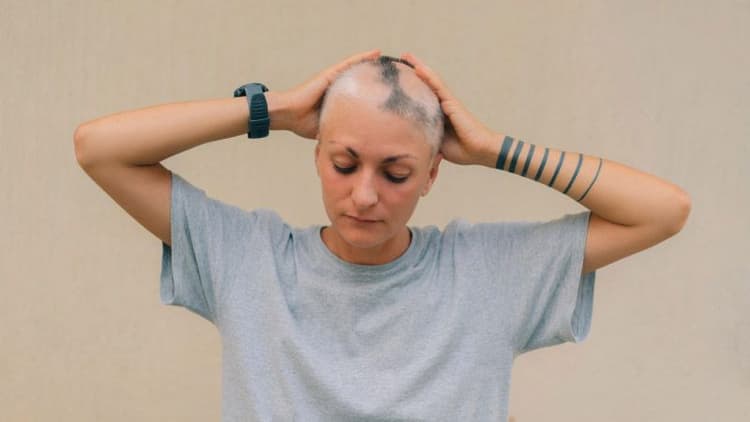Chemotherapy And Hair Loss: What To Expect During Treatment?
20 months ago
4 minute read.

We might not realize how much your hair means to you until you face the possibility of losing it. For people with cancer, especially those getting chemotherapy, losing hair is a big worry.
Chemotherapy is a powerful cancer treatment that works by targeting rapidly dividing cells, including cancer cells. While chemotherapy can be highly effective in fighting cancer, it can also lead to various side effects, including hair loss. Understanding what to expect during treatment and how hair regrowth occurs afterward can help individuals cope with this challenging aspect of chemotherapy.
The good news is, this hair loss is often temporary. Most people start to see their hair grow back a few weeks to a few months after they finish chemotherapy.
Must check: Cancer: Early detection, diagnosis, and treatment
Why Does Chemotherapy Cause Hair Loss?
Chemotherapy drugs work by targeting and destroying rapidly dividing cells, a characteristic of cancer cells. However, these drugs can also affect other rapidly dividing cells in the body, including those in the hair follicles. This interference disrupts the natural hair growth cycle, leading to hair loss. While not all chemotherapy drugs cause hair loss, many do, and the extent can vary widely from person to person.

Types of Hair Loss During Chemotherapy
Hair loss due to chemotherapy can occur in different ways and at different rates. Some patients experience gradual thinning of the hair, while others may lose their hair in clumps. The hair loss can affect the scalp, eyebrows, eyelashes, and even body hair. The timing of hair loss can also vary, with some people noticing it within a few weeks of starting treatment, while others may not experience it until later in their treatment cycle.

Timeline for Hair Regrowth
After chemotherapy treatment ends, many patients are eager to know when their hair will start to grow back. The timeline for hair regrowth can vary widely.
- 3–4 weeks: Light, fuzzy hair forms.
- 4–6 weeks: Thicker hair begins growing.
- 2–3 months: An inch of hair growth.
- 3–6 months: 2–3 inches of hair growth, covering bald patches. Individuals with really short hair in the past might be able to go back to their prior look.
- 12 months: 4–6 inches be long enough to brush or style
What Hair Growth After Chemo Looks Like?
The regrowth of hair after chemotherapy can be a gradual process, and the new hair may look and feel different from your pre-treatment hair. It may initially be thin, fine, and possibly a different texture or color than before. It is normal, and as your hair continues to grow, it will likely become thicker and more like your pre-treatment hair over time.
Also read: Want to speed up hair growth? Have these foods regularly
What Helps Hair Regrowth After Chemo?
While waiting for your hair to regrow, there are some steps you can take to support healthy hair growth:
- Be patient: Hair regrowth after chemotherapy is a slow process, and it's important to be patient with yourself and your body.
- Eat a balanced diet: A healthy diet rich in vitamins and minerals can support overall health, including hair growth. Consider foods high in protein, vitamins A, C, and E, iron, and omega-3 fatty acids.
- Consider scalp cooling: Some cancer centers offer scalp cooling treatments during chemotherapy, which can help reduce the likelihood of hair loss. This treatment works by reducing the blood flow to the hair follicles, which can help protect them from the effects of chemotherapy.
Also check: Sip your way to stronger hair: drinks to prevent hair loss
Coping with Hair Loss During Treatment
Experiencing hair loss can be emotionally challenging for many patients, as it is often a visible reminder of their illness. However, several strategies can help patients cope with this side effect:
- Consider a wig: Wigs can be a practical and stylish way to manage hair loss during treatment. Many cancer centers have resources to help patients find wigs that look and feel natural.
- Explore head coverings: Scarves, hats, and turbans are comfortable alternatives to wigs and can be a fun way to express personal style.
- Be gentle with your hair: Use a mild shampoo and avoid harsh chemicals or treatments that could further damage your hair.
- Protect your scalp: If you're going out in the sun, consider wearing a hat or using sunscreen to protect your scalp, which may be more sensitive during treatment.
Conclusion
Hair loss is a common side effect of chemotherapy, but it is often temporary. Understanding why it happens, what to expect during treatment, and how to manage hair regrowth afterward can help patients navigate this aspect of their cancer journey with greater ease. By taking care of their scalp and remaining hair, being patient with the regrowth process, and seeking support when needed, patients can feel more confident and empowered as they continue their treatment and recovery.
Leave a Comment
Related Articles
Health Checks @ Home
Service
Explore
© 2026 Truworth Health Technologies Pvt. Ltd.





